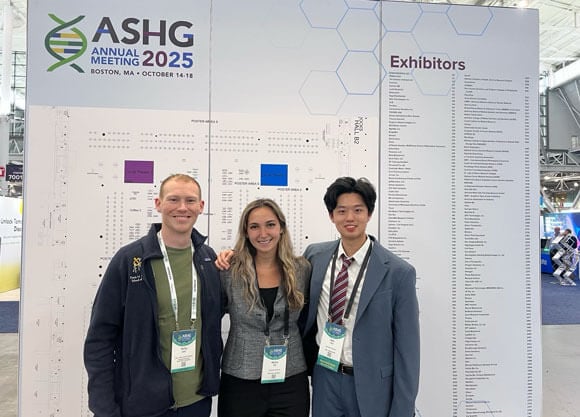
Students present cutting-edge research on neurogenomics at national conference
November 24, 2025

November 24, 2025

Phillip Smit, MD ‘26, was one of the Quinnipiac School of Medicine students to present their findings at the conference.
“I was initially nervous about presenting, especially once I saw the size of the room,” he said. “Once I got up to the podium, the minutes went by in a flash. It was a thrilling experience for me, and I'm proud I was able to represent our hard work.”
Alan Chai, MD ‘27, presented research on the genomic architecture of central nervous system structural birth defects, earning the Reviewers’ Choice Ribbon, recognizing the top 10 percent of posters at the conference.
In addition, Rachel Schlak, MD ‘27, and Katrina Etts, MD ‘27, shared their digenic model of inheritance for neural tube defect risk.
Smit and Paul Wolujewicz, assistant professor of biomedical sciences, started their collaboration through Quinnipiac’s scholarly reflection and concentration capstone course (SRCC), a program designed to provide opportunities for medical students to engage in connected research.
Wolujewicz’s dual appointment at Quinnipiac and Weill Cornell Medicine in New York City provided a bridge that enabled Quinnipiac students to participate in advanced, collaborative projects with their mentors.
Working alongside Dilek Colak at Weill Cornell’s Center for Neurogenetics, Smit used patient-derived brain organoid models to explore the biological causes behind autism spectrum disorder.
“Phil’s dedication, intellectual curiosity and strong foundation in biomedical sciences made him an ideal collaborator for this complex project,” said Wolujewicz.
For Smit, this research was more than just data and analytics.
“We both feel a calling to address the urgent needs in autism research,” said Smit. “Every day, I think about the children and families affected by this disorder, and that drives me to keep pushing forward.”
The team's work revealed common disruptions and patterns across genetic backgrounds, ultimately bringing insight to get one step closer to understanding autism and how it develops.
Looking ahead, the research could help find new ways to diagnose and intervene in autism earlier, giving families hope and a brighter future, the team agreed. A benefit of the patient-derived organoid models is that they can also offer a new, personalized and informed way to test new potential clients.
“It’s incredibly exciting to contribute to this field,” Smit said. “I can’t wait to see where this research leads over the next few years.”
For Wolujewicz, these are the moments in his career that represent the heart of his work.
“Quinnipiac fosters a culture that values mentorship and student research as central to the educational mission,” said Wolujewicz. “Watching Phil grow from learning analytical tools to presenting on an international stage has been incredibly rewarding.”
Both Smit and Wolujewicz give credit to Quinnipiac for providing the resources, mentorship and support that made their outstanding achievements possible.
The SRCC course combined with the institutional funding from Frank H. Netter MD School of Medicine allowed students to attend the conference and share their findings in an academic spotlight.
For everyone involved, this project was more than just a scientific breakthrough. It was about exploring natural curiosity and reaching deeper to reveal the unknown.
Together, Wolujewicz and Smit are helping shape the future of scientific discovery and advancing the university’s mission to improve human health.
Quinnipiac Today is your source for what's happening throughout #BobcatNation. Sign up for our weekly email newsletter to be among the first to know about news, events and members of our Bobcat family who are making a positive difference in our world.
Sign Up Now